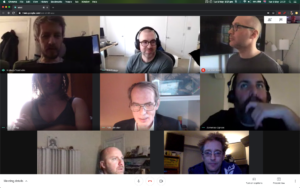Networked collaboration, telematic performances, and online learning have been growing in popularity for several years, but the lockdowns and social-distancing guidelines precipitated by the global COVID-19 pandemic have accelerated the adoption of these modes of interaction. This is a brief (and evolving) report on some of the solutions your fellow Kyma-nauts have found for practicing creative collaborations, live performances, private tutoring, consulting, and teaching large online courses. Thanks for sharing your input, feedback and alternative solutions for distance-collaboration with the Kyma community!
Note: For example configurations showing how to get audio onto your computer and out onto a network, read this first.
Kyma Kata
One of the earliest ongoing examples is Alan Jackson’s Kyma Kata, a regular meeting of peers who practice Kyma programming together, that has been operating online in Google Hangouts for over a year before the crisis and recently celebrated their 100th session! (Did they know something the rest of the world didn’t?) The Kyma Kata currently meets twice a week, on Mondays and Tuesdays. They begin each session with “Prime Minister’s Question Time” (open question-and-answer session on how to do specific tasks in Kyma), followed by an exercise that each person works on independently for 30 minutes, after which they share and discuss their results. Ostensibly the session lasts for 2 hours, but when people really get interested in a problem, some of them stick with it for much longer (though there is no honor lost if someone has to leave after two hours).

Collaboration platform
The Kata use Google Meet (née Hangouts) for their meetings, primarily because it seems to work on everyone’s computer and it integrates well with Slack. To start a Hangout, they just type /hangout into the Slack channel.
Audio from Kyma
Kata participants focus on how to do something together, so screen-sharing is important and audio quality has been less important: they often play over the air, using the computer’s built-in microphone to send the audio.

For higher quality audio, Alan uses a small USB mixer plugged in to the Mac as the Hangouts audio source. Using the mixer, he can mix the Paca’s output and a microphone which provides a lot better quality than over-the-air through the laptop’s mic, although it’s still limited by Hangout’s audio quality, delay and bandwidth.
What is the Kata and How do I sign up?
The term, kata, which comes to us by way of karate, has been adopted by software engineers as a way to regularly practice their craft together by picking a problem and finding several different solutions. The point of a kata is not so much arriving at a correct answer as it is to practice the art of programming.
In the Kyma Kata, a group of aspiring Kymanistas come together regularly via teleconferencing and the facilitator (Alan) introduces an exercise that everyone works independently for about half an hour, after which people take turns talking about their solutions. All levels of Kyma ability are welcome, so why not join the fun?
Improvisation with the Unpronounceables
The Unpronounceables are Robert Efroymson in Santa Fe New Mexico, Ilker Isikyakar in Albuquerque New Mexico, and Will Klingenmeier (ordinarily based in Colorado, but due to travel restrictions, on extended lockdown in Yerevan Armenia). To prepare for a live improvisation planned for KISS 2020, Robert proposed setting up some remote sessions using Jamulus.

Collaboration platform
Using the Jamulus software, musicians can engage in real-time improvisation sessions over the Internet. A single server running the Jamulus server software collects audio data from each Jamulus client, mixes the audio data and sends the mix back to each client. Initially, Robert set up a private server for the group, but they now use one of the public Jamulus servers as an alternative. One of the amusing side-effects of using the public server is that they are occasionally joined by uninvited random guests who start jamming with them.
During a session, the Unpronounceables use a Slack channel to communicate with each other by text and Jamulus to time-align and mix the three audio sources and for sending the mix to each of the three locations.
Audio from Kyma
Each Unpronounceable uses a second interface to get audio from Kyma to the host computer. Robert uses a Behringer to come out of Kyma, and an IO/2 to get to his Mac. Ilker sends his MOTU Track 16 audio outputs to a Behringer; then selects the Behringer as an I/O in the Jamulus preference tab. Will uses a ZOOM H4n as his Kyma interface and sends the audio to an M-Audio Fast Track Pro which acts as the interface for Jamulus.
Ecosystemic audio in virtual rooms
 Scott Miller and Pat O’Keefe’s HDPHN project has always been an exploration of what it means to be alone together — it’s a live public concert where each member of the audience wears headphones, rather than listening through speakers. When stay-at-home orders made it impossible for Scott in Otsego to meet in person with Pat in St. Paul, Minnesota, they started looking into how to move the live HDPHN performance onto the Internet.
Scott Miller and Pat O’Keefe’s HDPHN project has always been an exploration of what it means to be alone together — it’s a live public concert where each member of the audience wears headphones, rather than listening through speakers. When stay-at-home orders made it impossible for Scott in Otsego to meet in person with Pat in St. Paul, Minnesota, they started looking into how to move the live HDPHN performance onto the Internet.
 When Earth Day Art Model 2020 shifted from a live to an online festival, Scott and Pat used this as an opportunity to dive in and perform HDPHN along with one of their older pieces Zeitgeist live through the Internet.
When Earth Day Art Model 2020 shifted from a live to an online festival, Scott and Pat used this as an opportunity to dive in and perform HDPHN along with one of their older pieces Zeitgeist live through the Internet.
Audio from Kyma
Scott describes the audio routing for HDPHN as follows:
Pat’s mic comes over Zoom and out of my desktop headphone audio. It also goes into Kyma input 1 on my Traveller. With Zoom, I can’t get/send stereo from a live source. With two people (did this Friday) I bring the second person in on a separate Skype/Zoom/Facetime session on another device, and into Kyma input 2. With 2 inputs, I then mathematically cross-processing them in a virtual room.
I am sending Kyma’s processed/mixed output (Main 1-2) back into my desktop via Lynx E22 audio card, going into DSP-Quattro for compression and EQ, then to iShowU virtual audio interface 1) —> to Zoom for Pat’s monitoring, and 2) —>OBS and then to YouTube synced with Pat’s Zoom video. YouTube latency very bad and it wrecked chamber music with duo, but was fun for free improv with a different duo.
Live coding at a Virtual Club
On Monday, 11 May 2020, beginning at 20.30 CET Time, Lucretio will be live-coding in Kyma using a new Tool of his own design at The Circle UXR Zone. The Circle is a virtual club that is a UXR.zone — a decentralized social VR communication platform offering secure communication, free from user-tracking and ads. A spinoff project of the #30daysinVR transhumanist performance by Enea Le Fons, a UXR.zone allows participants to share virtual rooms and communicate via avatars across a range of devices: from VR headsets (main platform) to desktop and mobile phone browsers.
The avatars of people attending the UXR events are either anonymous (robots) or follow a strict dress code based on the CVdazzle research to stress the importance of cyber camouflage via aesthetics against dystopian surveillance measures happening in the real world. Click to enter the club
The belly of the BEAST
Simon Smith (who is actually quite a slender chap at the BEAST of Birmingham) has recently been tasked with researching online collaboration platforms for the BEAST, so we asked him for some tips from the front lines. He just completed a Sound and Music Workshop with Ximena Alarcon (earlier he helped Alarcon on a telematic performance using the Jacktrip software from Stanford).
In the workshop, she also mentioned:
- Artsmesh A network music and performance management tool. Content creators run the Artsmesh client which streams live media point-to-point; audiences run a light Artsmesh client to watch the shows.
- SoundJack is a realtime communication system with adjustable quality and latency parameters. Depending on the physical distance, network capacities, network conditions and routing, some degree of musical interaction is possible.
- Jitsi, an open source teleconferencing platform
Other options?
How have you been collaborating, teaching, consulting, creating during the lockdown? We’re interested in hearing your stories, solutions and experiences.
Have you used YouTube or Vimeo for live streaming with Kyma?
What’s your preferred video conferencing software for sending computer audio (Zoom, BigBlueButton, Meet)?
Have you been using remote desktop software (like Chrome Remote Desktop, Jump) to access your studio computer from home?
We welcome hearing about alternate solutions for this ongoing report.


 In 1999, astrophysicist/musician David McClain spent an intense three-month period working on The Northern Sky Survey, mapping the sky in the near infrared while getting by on an hour of sleep per night. When he finished the survey, he was suddenly struck by a viral infection that nearly killed him; his doctors were never able to determine the cause and, after three months, the infection dissipated almost as quickly as it had appeared. But afterward David noticed that he could no longer understand his wife when she was speaking to him. He went to an audiologist and discovered he had a sensorineural hearing loss of 60-70 dB in the high frequency range. Hearing aids helped him understand speech, but he was devastated to discover that music never sounded right through the hearing aids. But as a physicist, he was determined to solve the problem.
In 1999, astrophysicist/musician David McClain spent an intense three-month period working on The Northern Sky Survey, mapping the sky in the near infrared while getting by on an hour of sleep per night. When he finished the survey, he was suddenly struck by a viral infection that nearly killed him; his doctors were never able to determine the cause and, after three months, the infection dissipated almost as quickly as it had appeared. But afterward David noticed that he could no longer understand his wife when she was speaking to him. He went to an audiologist and discovered he had a sensorineural hearing loss of 60-70 dB in the high frequency range. Hearing aids helped him understand speech, but he was devastated to discover that music never sounded right through the hearing aids. But as a physicist, he was determined to solve the problem.

